Value Assessment of Artificial Wetland Derived from Mining Subsided Lake: A Case Study of Jiuli Lake Wetland in Xuzhou
Abstract
1. Introduction
2. Study Area and Methodology
2.1. Study Area
2.2. Methods
3. Results
3.1. Measurement on the Appreciation of the Jiuli Lake Wetland Ecosystem Services Value
3.1.1. Classification and Value Measurements of the Ecosystem Services
3.1.2. Value Assessment and Appreciation of Ecosystem Services of Jiuli Lake Wetland
3.2. Measuring the Spillover Effect of Jiuli Lake Wetland
3.2.1. Measurement Approaches of the Spillover Effect on the Land Price
3.2.2. Measuring the Value of the Spillover Effect
3.3. Measurement of the Cost of the Ecological Restoration Project
3.3.1. The Costs of Land Clearing and Resettlement Compensation
3.3.2. The Cost of Land Rearrangement
3.3.3. The Cost of Environmental Restoration
3.4. Value Assessment of Jiuli Lake Wetland
4. Conclusions and Discussion
Acknowledgments
Author Contributions
Conflicts of Interest
References
- Hu, Z.-Q.; Xiao, W.; Wang, P.-J.; Zhao, Y.-L. Concurrent mining and reclamation for underground coal mining. J. China Coal Soc. 2013, 38, 301–307. [Google Scholar]
- Chen, L.-Q.; Guo, D.-Z.; Xu, S.-K.; Li, J.-M.; Zhang, Y.-Z. A study on state and comprehensive control ways of subsided land of Yanzhou coal mining area in China. J. Nat. Resour. 2002, 17, 504–508. [Google Scholar]
- Xiao, W.; Hu, Z.-Q.; Fu, Y.-H. Zoning of land reclamation in coal mining area and new progresses for the past 10 years. Int. J. Coal Sci. Technol. 2014, 11, 177–183. [Google Scholar] [CrossRef]
- Lin, Z.-S.; Wang, G.-X. Remediation of Subsided Land and Creation of Artificial wetland in Mining Area—A case of Remediation of Subsided Land in Xuzhou Mining Area. J. Natl. Resour. 2005, 20, 790–795. [Google Scholar]
- Zhang, Q.-X.; Wang, F.; Wang, R.-S. Research Progress of Ecological Restoration for Wetlands in Coal Mine Areas. Procedia Environ. Sci. 2011, 10, 1933–1938. [Google Scholar] [CrossRef]
- Hu, Z.; Fu, Y.; Xiao, W.; Zhao, Y.; Wei, T. Ecological restoration plan for abandoned underground coal mine site in Eastern China. Int. J. Min. Reclam. Environ. 2015, 29, 316–330. [Google Scholar] [CrossRef]
- Guo, A.; Tang, X.; Li, X.; Xu, Y. The change of Tangshan Nanhu city Wetland Landscape based on multi-level classification method. In Proceedings of the International Conference on Computer Research & Development, Shanghai, China, 11–13 March 2011; Volume 2, pp. 440–443. [Google Scholar]
- Xie, K.; Zhang, Y.-Q.; Yi, Q.-T.; Yan, J.-P. Optimal resource utilization and ecological restoration of aquatic zones in the coal mining subsidence areas of the Huaibei Plain in Anhui Province, China. Desalination Water Treat. 2013, 51, 4019–4027. [Google Scholar] [CrossRef]
- Li, X.F.; Wang, J.M.; Wu, K.N. Restoration of water system in coalmine subsided area with higher level of underground water—Taking Jiawang mining area of Xuzhou as an example in China. Adv. Mater. Res. 2012, 518, 4227–4232. [Google Scholar] [CrossRef]
- Zedler, J.B. Progress in wetland restoration ecology. Trends Ecol. Evol. 2000, 15, 402–407. [Google Scholar] [CrossRef]
- Clarkson, B.R.; Ausseil, A.G.E.; Gerbeaux, P. Wetland ecosystem services. In Ecosystem Services in New Zealand: Conditions and Trends; Manaaki Whenua Press: Lincoln, New Zealand, 2013; pp. 192–202. [Google Scholar]
- He, J.; Moffette, F.; Fournier, R.; Revéret, J.P.; Théau, J.; Dupras, J.; Varin, M. Meta-analysis for the transfer of economic benefits of ecosystem services provided by wetlands within two watersheds in Quebec, Canada. Wetl. Ecol. Manag. 2015, 23, 707–725. [Google Scholar] [CrossRef]
- Peh, K.S.H.; Balmford, A.; Field, R.H.; Lamb, A.; Birch, J.C.; Bradbury, R.B.; Sedgwick, I. Benefits and costs of ecological restoration: Rapid assessment of changing ecosystem service values at a UK wetland. Ecol. Evol. 2014, 4, 3875–3886. [Google Scholar] [CrossRef] [PubMed]
- Hui, E.C.; Liang, C. Spatial spillover effect of urban landscape views on property price. Appl. Geogr. 2016, 72, 26–35. [Google Scholar] [CrossRef]
- Gibbons, S.; Mourato, S.; Resende, G.M. The amenity value of English nature: A hedonic price approach. Environ. Resour. Econ. 2014, 57, 175–196. [Google Scholar] [CrossRef]
- Liang, M.Z.; Liu, Z.H. Leisure and recreation value of urban artificial wetland scenic area: Taking Nansha wetland park of Guangzhou city for example. Urban Problems. 2014, 7, 8. [Google Scholar]
- Ragkos, A.; Psychoudakis, A.; Christofi, A.; Theodoridis, A. Using a functional approach to wetland valuation: The case of Zazari–Cheimaditida. Reg. Environ. Chang. 2006, 6, 193–200. [Google Scholar] [CrossRef]
- Dubgaard, A. Cost-benefit analysis of wetland restoration. J. Water Land Dev. 2004, 8, 87–102. [Google Scholar]
- Costanza, R.; Chichakly, K.; Dale, V.; Farber, S.; Finnigan, D.; Grigg, K.; Magnuszewski, P. Simulation games that integrate research, entertainment, and learning around ecosystem services. Ecosyst. Serv. 2014, 10, 195–201. [Google Scholar] [CrossRef]
- Millennium Ecosystem Assessment Board. Ecosystems and Human Well-Being: Health Synthesis; World Resources Institute: Washington, DC, USA, 2005. [Google Scholar]
- The Economics of Ecosystems and Biodiversity (TEEB). The Economics of Ecosystems and Biodiversity: Ecological and Economic Foundations; Earthscan: London, UK; Washington, DC, USA, 2010. [Google Scholar]
- Armbrecht, J. Use value of cultural experiences: A comparison of contingent valuation and travel cost. Tour. Manag. 2014, 42, 141–148. [Google Scholar] [CrossRef]
- Thapa, A.K. Recreational Demand for Fewa Lake: An Application of Travel Cost Method. Econ. Lit. 2016, 11, 54–59. [Google Scholar] [CrossRef]
- Wei, Q.; Tong, L.; Gondwe, J.; Lv, X.; Tong, W.; Liu, Y. Non-use value trends analysis of wetland ecosystem in the Sanjiang Plain, Northeast China. Wetl. Ecol. Manag. 2015, 23, 347–355. [Google Scholar] [CrossRef]
- Xie, G.; Cao, S.; Xiao, Y.; Pei, X.; Bai, Y.; Li, W.; Min, Q. Ecosystem Service Evaluation. In Contemporary Ecology Research in China; Springer: Berlin/Heidelberg, Germany, 2015; pp. 133–177. [Google Scholar]
- Seppelt, R.; Dormann, C.F.; Eppink, F.V.; Lautenbach, S.; Schmidt, S. A quantitative review of ecosystem service studies: Approaches, shortcomings and the road ahead. J. Appl. Ecol. 2011, 48, 630–636. [Google Scholar] [CrossRef]
- De Groot, R.S.; Wilson, M.A.; Boumans, R.M.J. A typology for the classification, description and valuation of ecosystem functions, goods and services. Ecol. Econ. 2002, 41, 393–408. [Google Scholar] [CrossRef]
- Chen, Z.; Zhang, A.; Song, M.; Zhang, Z. Measuring external costs of rural–urban land conversion: An empirical study in Wuhan, China. Acta Ecol. Sin. 2016, 36, 30–35. [Google Scholar] [CrossRef]
- Yun, R.-W.; Zhang, S.-L.; Ruan, B.-J.; Xu, Z.-J. Review of Researches on Land Price Change Law Based on Urban Ecological Landscape. Resour. Dev. Mark. 2009, 25, 524–527. [Google Scholar]
- Zhang, Y. Study on Spillover Effect of the Construction of Urban Green Space on Residential Land Value; China University of Mining and Technology: Xuzhou, China, 2014. [Google Scholar]
- Gao, J.-L.; Chen, J.-L.; Su, X. Influencing factors of land price in Nanjing Proper during 2001–2010. Prog. Geogr. 2014, 33, 211–221. [Google Scholar]
- Building test training research center. Land Valuation Methods; China Building Industry Press: Beijing, China, 2013. [Google Scholar]
- Zhou, G. The Micro Factors and Empirical Reserch on Urban Land Prices; Zhejiang University: Hangzhou, China, 2004. [Google Scholar]
- Panduro, T.E.; Veie, K.L. Classification and Valuation of Urban Green Spaces—A Hedonic House Price Valuation. Landsc. Urban Plan. 2013, 120, 119–128. [Google Scholar] [CrossRef]
- Gutjahr, A. Geostatistics for Sampling Designs and Analysis; ACS Symposium Series; American Chemical Society: Washington, DC, USA, 1991. [Google Scholar]
- Wong, W.S.D.; Lee, J. Statistical Analysis of Geographic Information with ArcView GIS and ArcGIS; Wiley: Hoboken, NJ, USA, 2005. [Google Scholar]
- Wu, Z.; Han, K. Research on Urban Land Grading Based on ArcGIS. Surv. Mapp. Geol. Miner. Resour. 2013, 4, 1. [Google Scholar]
- Wang, N. Study on the Urban Land Price Model; China University of Geosciences: Beijing, China, 2009. [Google Scholar]
- Ord, K.; Cliff, A.D. The Comparison of Means When Samples Consist of Spatially Autocorrelated Observations. Environ. Plan. A 1975, 7, 725–734. [Google Scholar]
- Chang, K. Introduction to Geographic Information Systems; McGraw-Hill Higher Education: Boston, MA, USA, 2006. [Google Scholar]
- Chen, G.S.; Tian, L. Research on Compensation Issues of Urban Resettlement in China. Adv. Appl. Econ. Bus. Dev. 2011, 209, 395–401. [Google Scholar]
- Qu, S.; Heerink, N.; Xia, Y. Farmers’ satisfaction with compensation for farmland expropriation in China—Evidence from micro-level data. In Proceedings of the 2015 Conference on International Association of Agricultural Economists, Milan, Italy, 9–14 August 2015. [Google Scholar]
- Tang, Y.; Mason, R.J.; Wang, Y. Governments’ functions in the process of integrated consolidation and allocation of rural–urban construction land in China. J. Rural Stud. 2015, 42, 43–51. [Google Scholar] [CrossRef]
- Zou, X.; Oskam, A.J. New compensation standard for land expropriation in China. China World Econ. 2007, 15, 107–120. [Google Scholar] [CrossRef]
- State Council of the PRC. Regulations on the Levy and Compensation of houses on State Owned Land [R/OL]. Available online: http://www.gov.cn/flfg/2011-01/21/content_1791480.htm (accessed on 21 January 2011).
- The Standing Committee of Jiangsu Provincial People’s Congress. Regulations of Jiangsu Municipality on the Administration of Urban Housing Units [R/OL]. Available online: http://www.jsrd.gov.cn/zyfb/sjfg/200812/t20081231_1748.shtml (accessed on 23 October 2002).
- The Standing Committee of Jiangsu Provincial People’s Congress. Regulations of Xuzhou City on the Reclamation of Coal Mining Subsidence Land [R/OL]. Available online: http://www.xz.gov.cn/zgxz/zwgk/20041229/008003001_ffeaa5db-5837-4a11-9c1d-8b88b043cac4.htm (accessed on 3 November 2002).
- White, P.; Dranke, M.; Hindle, P. Integrated Solid Waste Management: A Lifecycle Inventory; Springer Science & Business Media: Berlin, Germany, 2012. [Google Scholar]
- Li, W.B.; Yao, J.; Tao, P.P.; Hu, H.; Fang, C.R.; Shen, D.S. An innovative combined on-site process for the remote rural solid waste treatment–A pilot scale case study in China. Bioresour. Technol. 2011, 102, 4117–4123. [Google Scholar] [CrossRef] [PubMed]
- Haibin, L.; Zhenling, L. Recycling utilization patterns of coal mining waste in China. Resour. Conserv. Recycl. 2010, 54, 1331–1340. [Google Scholar] [CrossRef]
- Wu, S.; Chang, X.; Tan, G. Research on the Efficiency Difference and Influencing Factors of Waste Gas Treatment by China’s Environmental Protection Investment—Based on the Panel Data of 29 Provinces and Cities. Stat. Educ. 2010, 5, 16–23. [Google Scholar]
- Zhengfu, B.I.A.N.; Inyang, H.I.; Daniels, J.L.; Frank, O.T.T.O.; Struthers, S. Environmental issues from coal mining and their solutions. Min. Sci. Technol. 2010, 20, 215–223. [Google Scholar]
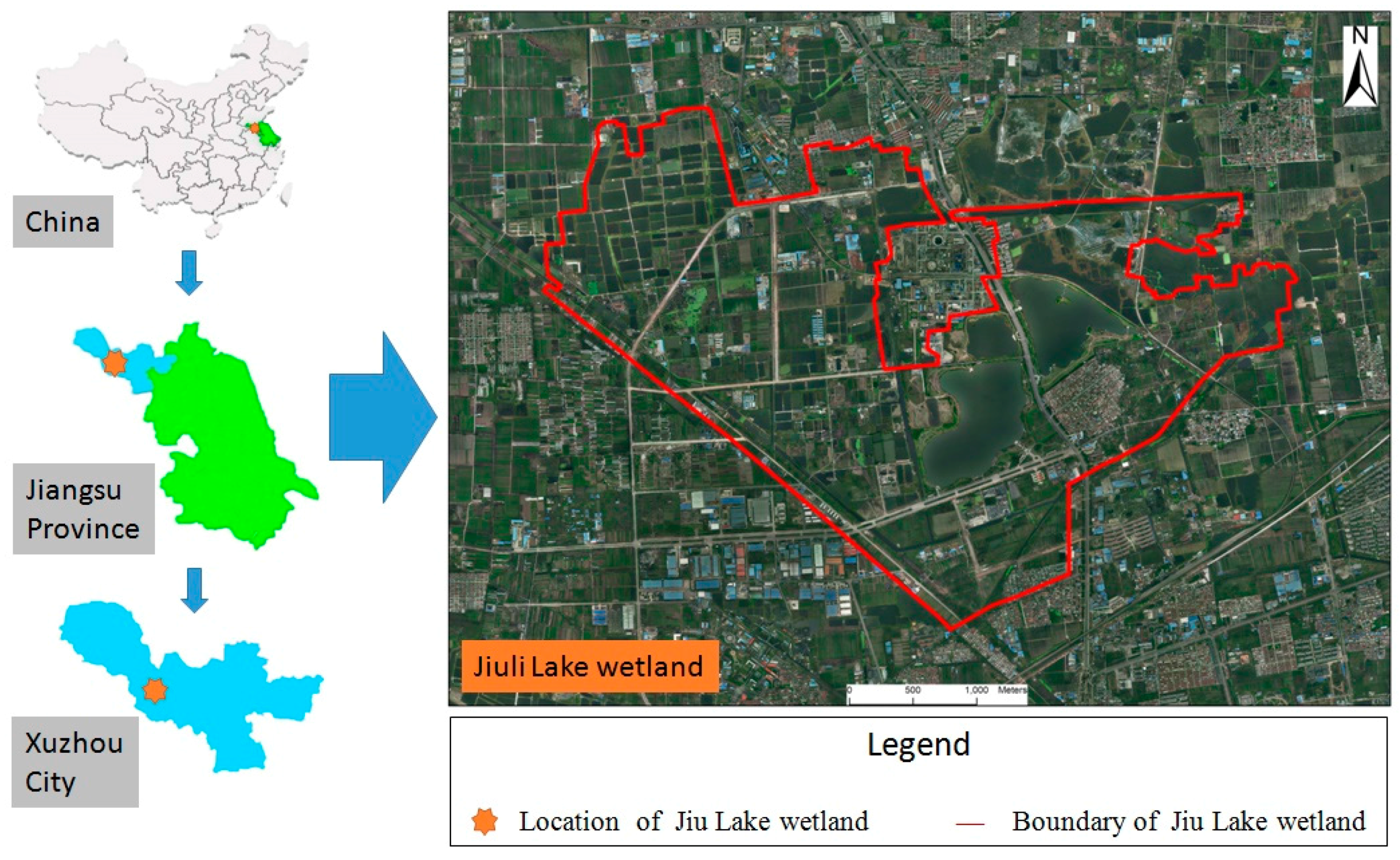

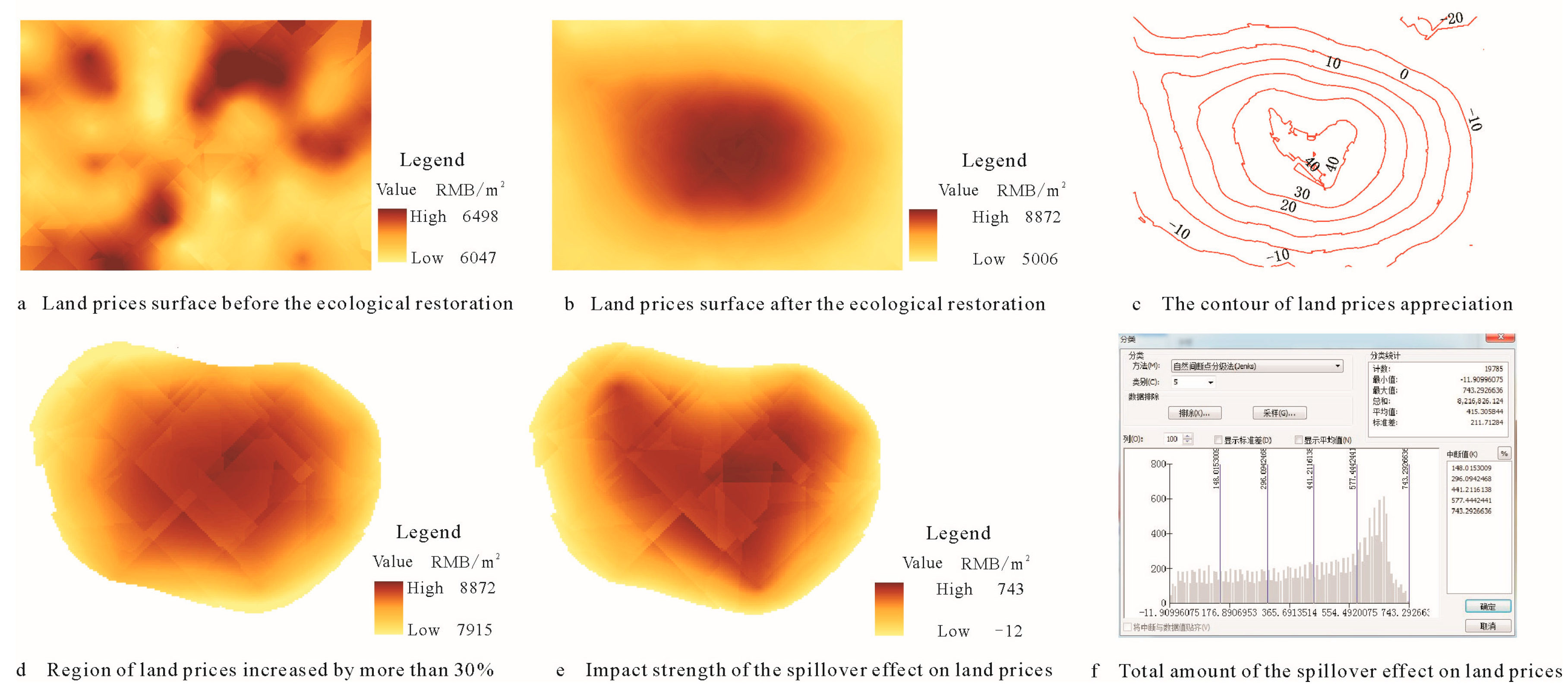
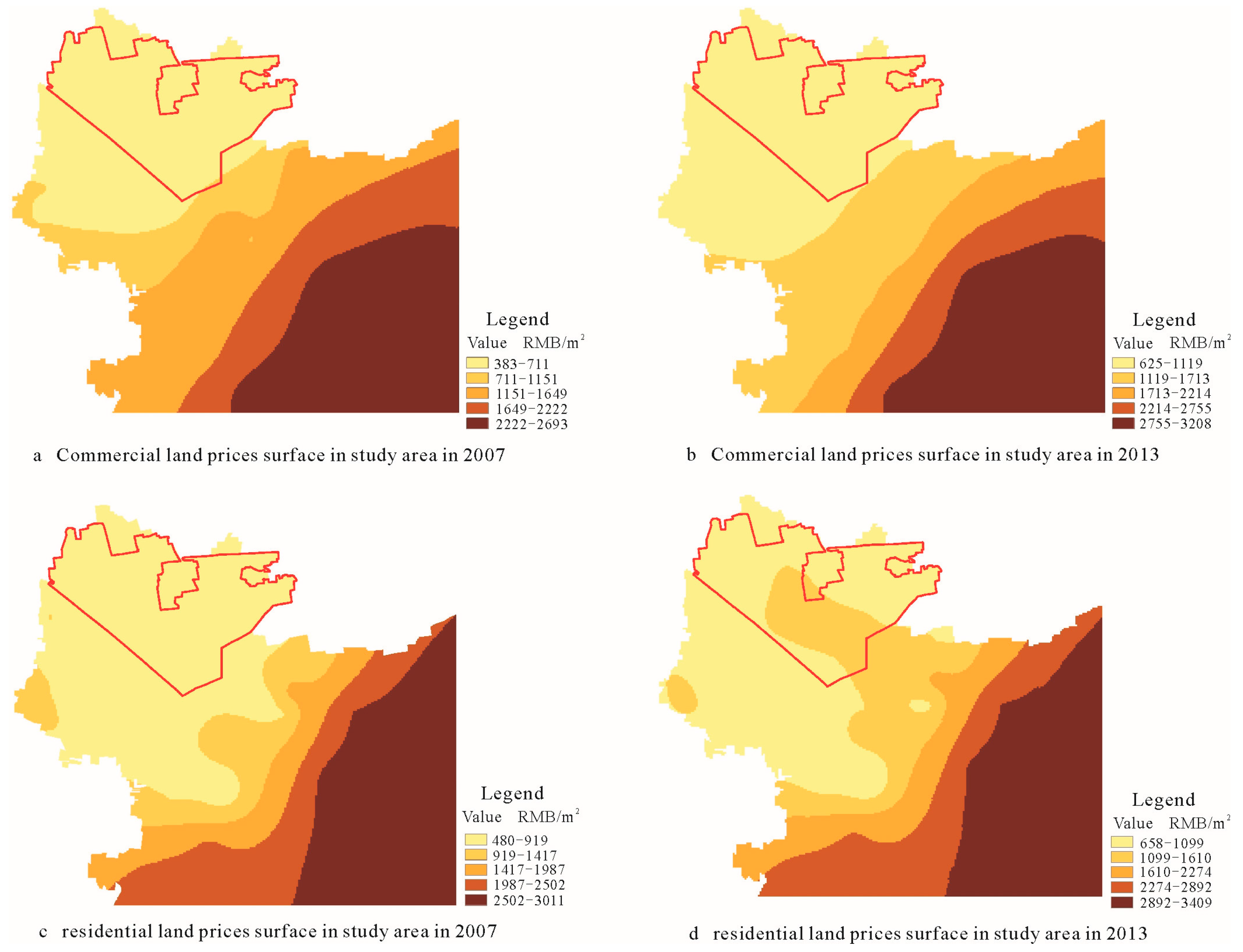
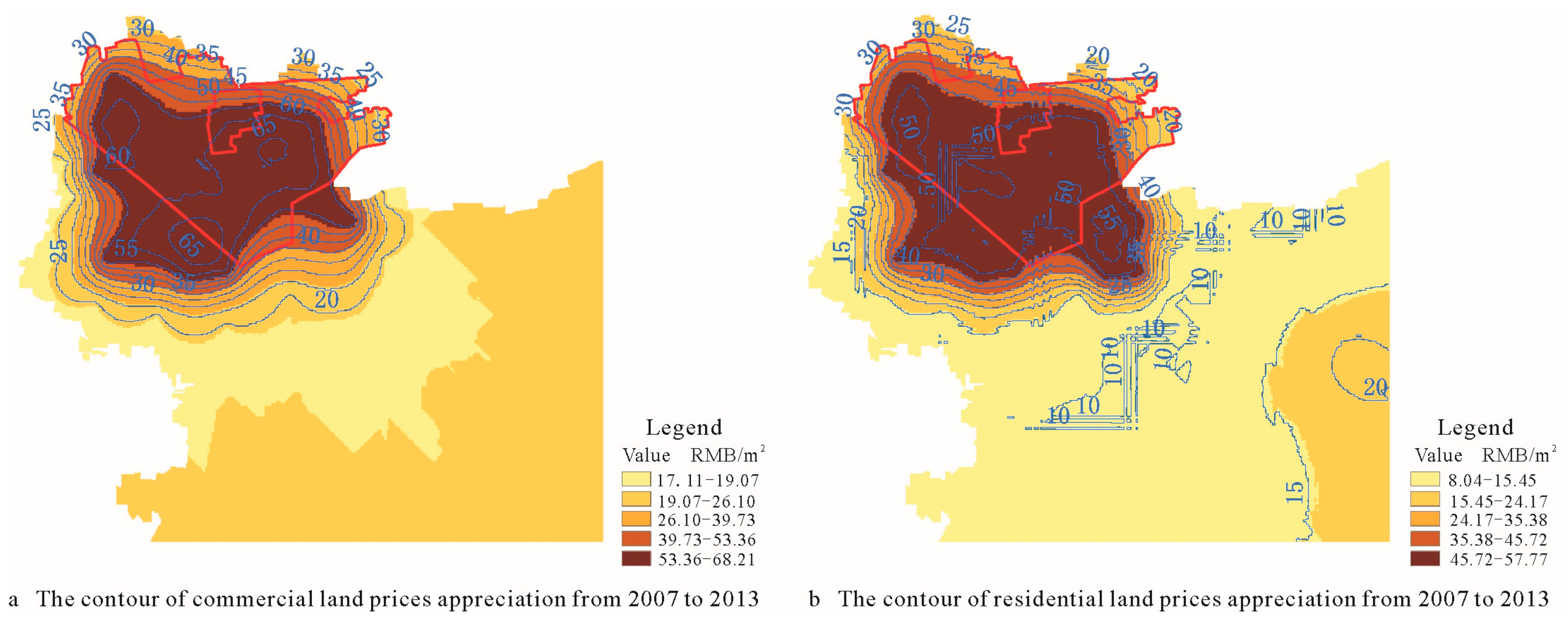
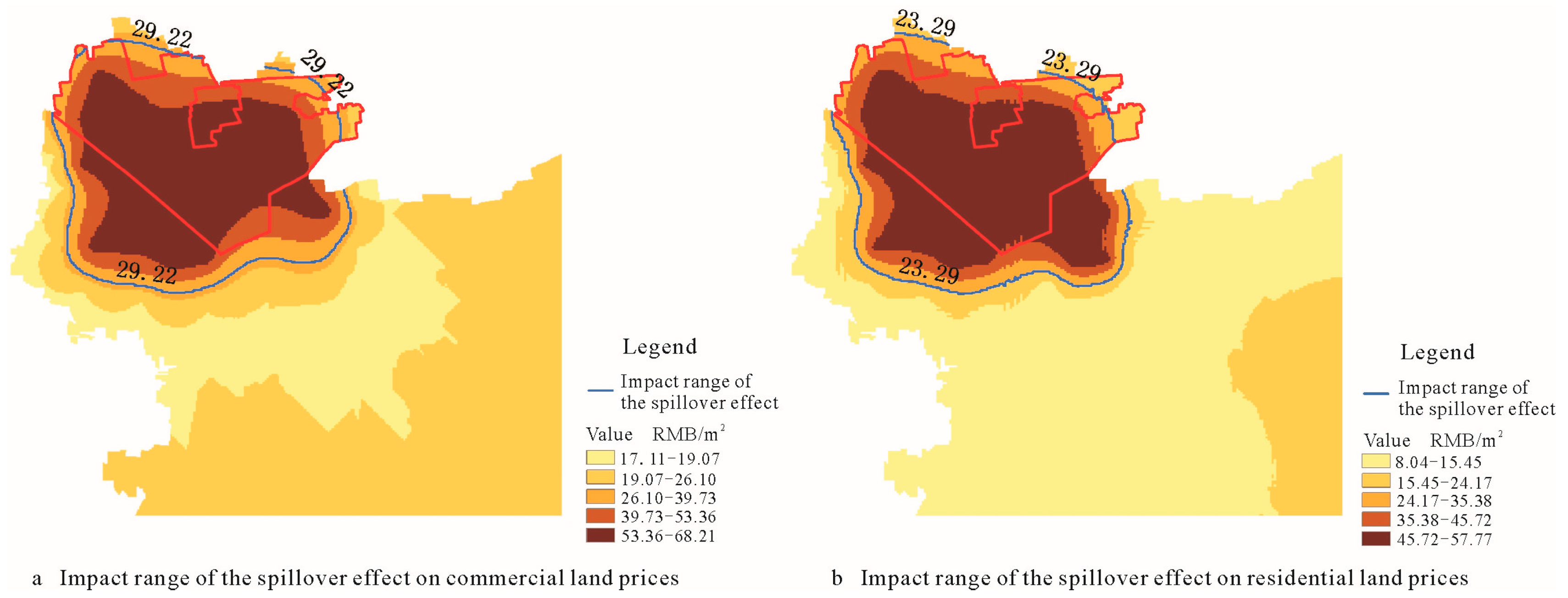

| Ecosystem Type | Ecosystem Structure |
|---|---|
| Farmland | Agricultural land, including land for food crops and cash crops |
| Aquacultural land | Fish ponds, etc. |
| Woodland | Woodland and orchards, etc. |
| Waters | Rivers, lakes, ditches, etc. |
| Townships | Towns, village residential, industrial lands, roads, etc. |
| Wetland | Swamps, wetland in parks, etc. |
| Ecosystem Type | Farmland | Aquacultural Land | Woodland | Waters | Townships | Wetland | |
|---|---|---|---|---|---|---|---|
| Ecosystem Service | |||||||
| Lifestyle and production related material supply | Material production | √ | √ | √ | √ | √ | |
| Life support and maintenance | Climate regulation | √ | √ | √ | √ | ||
| Moisture regulation | √ | √ | √ | √ | √ | ||
| Environmental cleanup | √ | √ | √ | ||||
| Soil formation and conservation | √ | √ | |||||
| Biodiversity maintenance | √ | √ | √ | ||||
| Nutrient cycling | √ | √ | √ | ||||
| Spiritual enjoyment | Cultural diversity | √ | √ | ||||
| Leisure and travel | √ | √ |
| Ecosystem Service | Method | |
|---|---|---|
| Lifestyle and production related material supply | Material production | Market value method |
| Life support and maintenance | Climate regulation | Carbon tax and afforestation costs |
| Moisture regulation | Alternative engineering method | |
| Environmental cleanup | Alternative cost method | |
| Soil formation and conservation | Opportunity cost method | |
| Biodiversity maintenance | Recovery and protection costs | |
| Nutrient cycling | Alternative cost method | |
| Spiritual enjoyment | Cultural diversity | Conditional value method |
| Leisure and travel | Travel cost method and Conditional value method | |
| Ecosystem Type | Farmland | Aquacultural Land | Woodland | Waters | Township | Wetland | |
|---|---|---|---|---|---|---|---|
| Year | |||||||
| 2007 | 134.98 | 57.26 | 10.49 | 171.70 | 1111.38 | 2.39 | |
| 2013 | 58.12 | 42.17 | 10.68 | 215.20 | 841.12 | 3.19 | |
| Year | 2007 | 2013 | Value Appreciation | |
|---|---|---|---|---|
| Ecosystem Service | ||||
| Material production | 948.81 | 940.25 | −8.56 | |
| Climate regulation | 206.53 | 127.11 | −79.42 | |
| Moisture regulation | 16.46 | 19.29 | 2.83 | |
| Environment cleanup | 17.70 | 23.30 | 5.60 | |
| Soil formation and conservation | 0.18 | 0.19 | 0.01 | |
| Nutrient cycling | 0.13 | 0.15 | 0.02 | |
| Biodiversity maintenance | 12.92 | 8.86 | −4.06 | |
| Cultural diversity | 3.51 | 4.68 | 1.17 | |
| Recreation | 0 * | 167,105.84 | 167,105.84 | |
| Total | 1206.24 | 168,229.67 | 167,023.43 | |
| Item | Cost Type | Unit: Ten Thousand RMB | |
|---|---|---|---|
| Land clearing and Compensation cost | Collective land acquisition cost | Compensation for land expropriation (not including attachment) | 5576.29 |
| Compensation for above-ground attachments | 182.84 | ||
| Compensation for above-ground structures | 1584.65 | ||
| Cultivated land reclamation cost | 247.62 | ||
| Expropriation management cost | 293.64 | ||
| Compensation for above-ground buildings | 5891.13 | ||
| Above-ground structures | 652.78 | ||
| State-owned land reserves acquisition cost | Compensation for construction land without subsidence | 46,327.82 | |
| Compensation for construction land with subsidence | 15,766.66 | ||
| Compensation for agricultural land and unused land | 20,679.46 | ||
| Relocation cost, transition cost and temporary resettlement subsidies | 58.75 | ||
| Loss due to suspended economic operations | 428 | ||
| Loss due to equipment relocation | 820 | ||
| Land assessment cost | 7.27 | ||
| Field survey cost | 16.54 | ||
| Land rearrangement cost | Land leveling cost | 5450.45 | |
| Supporting infrastructure cost | 56,777.83 | ||
| Environment remediation cost | Water treatment cost | 1650 | |
| Solid waste treatment cost | 3565 | ||
| Waste gas treatment cost | 1770 | ||
| Ecological restoration project cost | 6520.7 | ||
| The Ecological restoration project cost | Total | 174,267.43 | |
© 2017 by the authors. Licensee MDPI, Basel, Switzerland. This article is an open access article distributed under the terms and conditions of the Creative Commons Attribution (CC BY) license (http://creativecommons.org/licenses/by/4.0/).
Share and Cite
Wang, L.; Wang, L.; Yin, P.; Cui, H.; Liang, L.; Wang, Z. Value Assessment of Artificial Wetland Derived from Mining Subsided Lake: A Case Study of Jiuli Lake Wetland in Xuzhou. Sustainability 2017, 9, 1860. https://doi.org/10.3390/su9101860
Wang L, Wang L, Yin P, Cui H, Liang L, Wang Z. Value Assessment of Artificial Wetland Derived from Mining Subsided Lake: A Case Study of Jiuli Lake Wetland in Xuzhou. Sustainability. 2017; 9(10):1860. https://doi.org/10.3390/su9101860
Chicago/Turabian StyleWang, Laijian, Lachun Wang, Pengcheng Yin, Haiyang Cui, Longwu Liang, and Zhenbo Wang. 2017. "Value Assessment of Artificial Wetland Derived from Mining Subsided Lake: A Case Study of Jiuli Lake Wetland in Xuzhou" Sustainability 9, no. 10: 1860. https://doi.org/10.3390/su9101860
APA StyleWang, L., Wang, L., Yin, P., Cui, H., Liang, L., & Wang, Z. (2017). Value Assessment of Artificial Wetland Derived from Mining Subsided Lake: A Case Study of Jiuli Lake Wetland in Xuzhou. Sustainability, 9(10), 1860. https://doi.org/10.3390/su9101860





